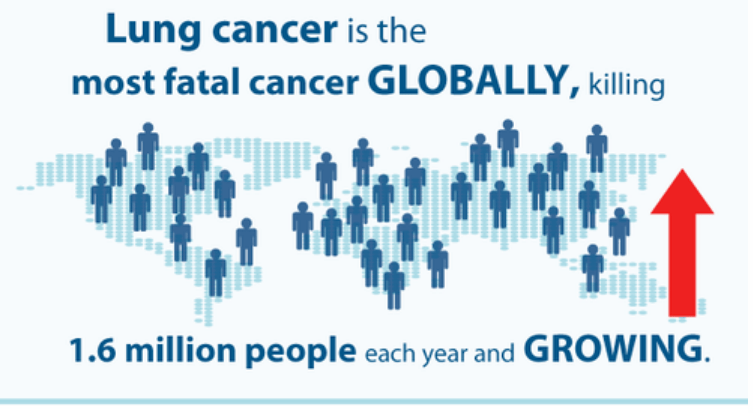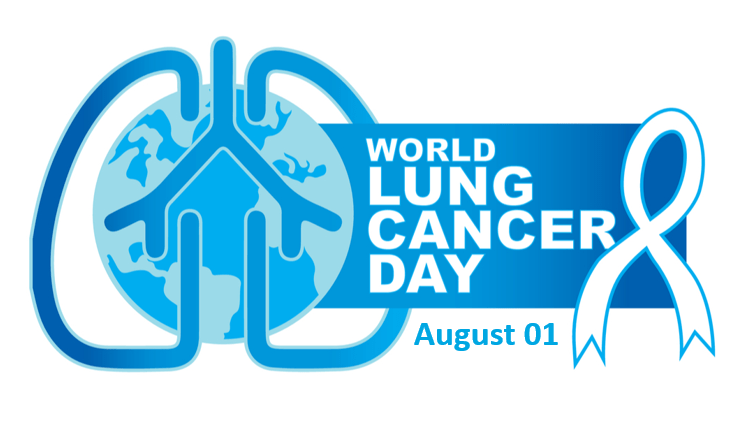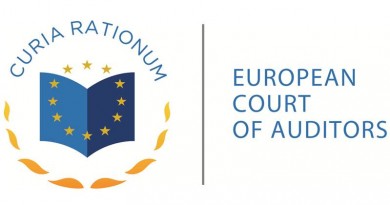World Lung Cancer Day August 01 – Close the Care Gap
Every year on August 1st, World Lung Cancer Day is observed to promote awareness and educate people all over the world about the serious challenges surrounding lung cancer, as well as to encourage more funding and moral support for lung cancer research.
On World Lung Cancer Day 2023, various activities will take place around the world, including the “5k Challenge” by the Union for International Cancer Control (UICC), which encourages people of all backgrounds to participate in activities like running, cycling, swimming, hiking, or walking to symbolize closing the care gap. There will also be “21-day challenges” for people to start new healthy habits, raise awareness about cervical cancer, and learn about inequities in cancer care access.
The World Lung Cancer Day will also examine the socioeconomic variables that contribute to disparities in cancer prevention, incidence, and survival, such as cultural and gender norms, income and education levels, and age, gender, ethnicity, handicap, and lifestyle biases. There will also be a demand for more effort to raise cancer awareness, prevent cancer, encourage improvements in detection and treatment, and solve health-system flaws highlighted by the COVID-19 pandemic. Interviews will also be available with WHO and partners from various areas and WHO countries throughout the world.
Lung cancer is one of the most frequent diseases in the world, the second leading cause of death worldwide, representing nearly 1 in 6 deaths globally, or 20% of overall cancer mortality. Lung cancer claims more lives yearly than breast, colon and prostate cancers combined. It is also one of the most common cancers among men in developing countries.

It is a type of cancer that starts in the lungs and is most common in smokers (both smokers and persons exposed to secondhand smoke), while lung cancer can occur in people who have never smoked.
In its early stages, lung cancer frequently does not produce symptoms. Lung cancer signs and symptoms often appear when the disease has progressed to an advanced stage.
The framework for action on cancer prevention and control was developed and endorsed in 2017 (and updated in 2018) to scale up guidance to countries and support implementation of the regional framework for action to implement the Political Declaration of the High-Level Meeting of the United Nations General Assembly on the Prevention and Control of Noncommunicable Diseases and World Health Assembly resolution (WHA70.12) on cancer prevention and control in the context of the World Health Assembly resolution (WHA70.12) on cancer prevention and control in the context of the World Health Assembly
The framework offers metrics that governments can use to track success in six critical areas: governance, prevention, early detection, treatment, palliative care, and surveillance and research. The framework will help to guide decision-making on policy alternatives and priority interventions for cancer prevention and control, as well as allow countries to choose which aspects of cancer prevention and control should be scaled up based on national contexts.
Lung Cancer Risk Factors
These are some Lung Cancer risk factors.
Tobacco use, including passive smoking, radiation therapy, radon gas, asbestos, and other toxins
Family history Elderly population
Obesity
Abuse of alcohol
Infections caused by viruses (HPV)
The Origins of World Lung Cancer Day
The Forum of International Respiratory Societies initiated the campaign for lung cancer and related concerns in 2012, in partnership with the International Association for the Study of Lung Cancer and the American College of Chest Physicians. The World Conference on Lung Cancer is the world’s most prominent organization dedicated solely to lung cancer-related issues and education.
The campaign was launched with the goal of providing education on lung cancer issues to both people who have recovered and those who have been diagnosed. The primary goal was to educate people about the key causes of lung cancer and how to prevent it.
Lung cancer is the most frequent cancer worldwide, according to the World Health Organization, with more than two million new cases diagnosed each year. It is also the leading cause of cancer mortality, killing 1.76 million people each year.
Furthermore, the NHS reports that over 43,000 persons in the UK are diagnosed each year.
But what are the symptoms of lung cancer, how is the disease diagnosed, and what therapies are available?
What are the signs and symptoms of lung cancer?
Lung cancer frequently has no early symptoms, but individuals who have it will ultimately notice symptoms.
Coughing up blood, chronic breathlessness, inexplicable weariness and weight loss, and aches and pains when breathing or coughing are all symptoms.
Wheezing, a hoarse voice, swelling of your face or neck, persistent chest or shoulder pain, difficulty swallowing, and fingers that seem visibly different are less typical symptoms of the condition.
Those who exhibit these symptoms should consult their doctor.
How is lung cancer identified?
If a patient visits their doctor because they are suffering lung cancer symptoms, their doctor will most likely ask them further questions, examine them, and ask them to breathe into a device called a spirometer to measure their breaths.
They may also request a blood test to rule out chest infections and other diseases that could be causing symptoms.
The following stage would be a chest X-ray, followed by a CT scan and maybe a PET-CT scan. If each scan indicates the presence of a mass, doctors may decide to perform a bronchoscopy, which involves passing a camera down your throat to gain a better understanding, or an endobronchial ultrasound scan, which combines a bronchoscopy with an ultrasound scan.
A biopsy will almost certainly be required so that the doctor can determine what type of malignant cells the patient has.
Non-small-cell lung cancer and small-cell lung cancer are the two most common kinds of lung cancer, often known as primary lung cancer.
Non-small-cell lung cancer is the most common, accounting for 80 to 85 percent of all cases. Small-cell lung cancer is a less prevalent kind that spreads much more quickly.
What is the treatment for lung cancer?
The treatment approach for lung cancer is determined by the type of cancer, the extent to which it has spread, and the patient’s overall health.
Surgery can be done to remove the damaged section of the lung if the patient was detected early and the malignant cells had not progressed far.
If surgery is not an option, radiation will most likely be employed to kill malignant cells.
However, if cancer has spread beyond the scope of surgery or radiotherapy, chemotherapy will be used.
Immunotherapy, in which a collection of drugs attempts to boost your immune system to attack cancer cells, can also be used alone or in conjunction with chemotherapy.
The Global Cancer Observatory (GCO)
The Global Cancer Observatory (GCO) is a web-based interactive platform that presents global cancer statistics to inform cancer control and research. The platform focuses on the visualization of cancer indicators using data from the IARC’s Cancer Surveillance Branch, such as GLOBOCAN, Cancer Incidence in Five Continents (CI5), International Incidence of Childhood Cancer (IICC), and several cancer survival benchmarking projects (SurvCan and SURVMARK).
The GCO is always evolving, and the team will continue to look for new and useful ways to display global cancer data that are related to IARC’s research efforts.




